PUBH6005 : Epidemiology PDF
VerifiedAdded on 2021/11/11
|13
|4193
|85
AI Summary
Contribute Materials
Your contribution can guide someone’s learning journey. Share your
documents today.
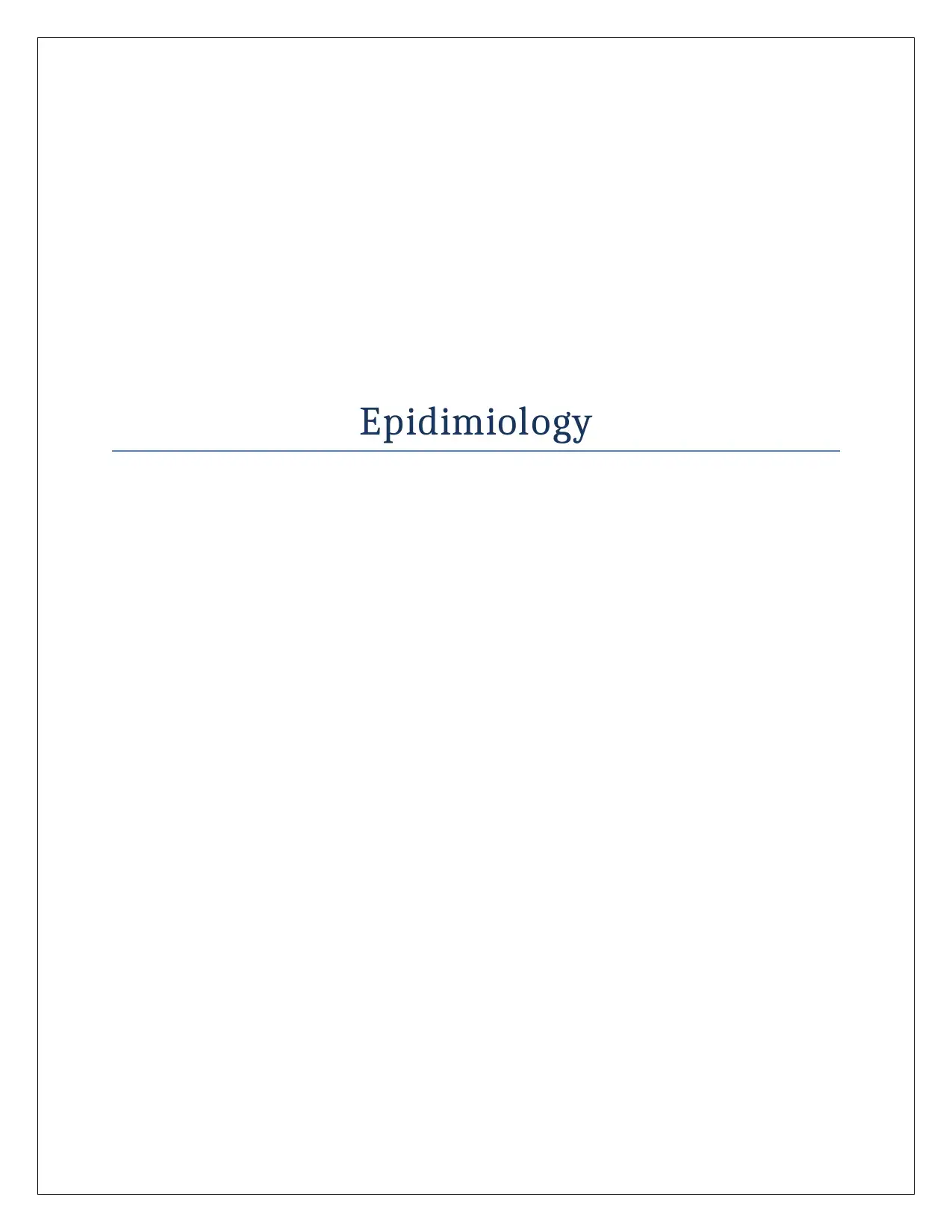
Epidimiology
Secure Best Marks with AI Grader
Need help grading? Try our AI Grader for instant feedback on your assignments.
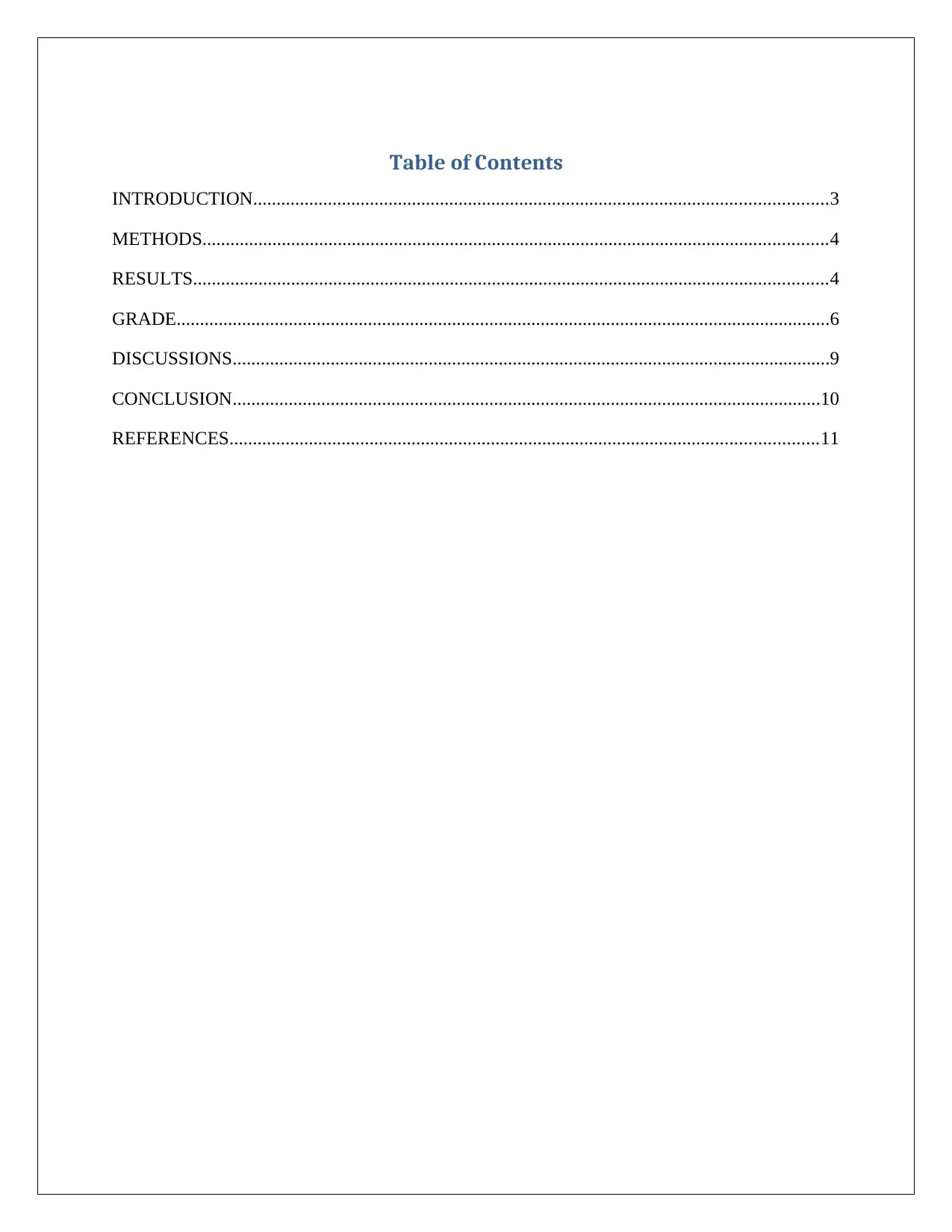
Table of Contents
INTRODUCTION...........................................................................................................................3
METHODS......................................................................................................................................4
RESULTS........................................................................................................................................4
GRADE............................................................................................................................................6
DISCUSSIONS................................................................................................................................9
CONCLUSION..............................................................................................................................10
REFERENCES..............................................................................................................................11
INTRODUCTION...........................................................................................................................3
METHODS......................................................................................................................................4
RESULTS........................................................................................................................................4
GRADE............................................................................................................................................6
DISCUSSIONS................................................................................................................................9
CONCLUSION..............................................................................................................................10
REFERENCES..............................................................................................................................11

INTRODUCTION
Antibiotics are those medications, which are utilized to treat microbial infections either by
executing them or by ceasing the development of microorganism.We are using anti-microbial
drugs since 1950s, but now a new problem with the anti-microbial drugs has been raised.
Microorganisms are now developing immunity against these drugs. Therefore, many bacteria and
other microorganisms are becoming resistant to these drugs. Another problem raised in this topic
is, we have already over-exploited the natural source of these anti-microbial drugs and now, it is
very difficult to formulate new drugs for this purpose (Shi et al., 2014). There are certain natural
remedies which can be used in the place of synthetic drugs. One of them is honey. Peroxides
present in the honey helps in the prevention of the microbial growth thus it is helpful in the
treatment of infections. Further honey like ‘manuka’ has some healing properties which can be
used to cure the wounds. Thus, when honey is applied on the wounds, it acts as both, it provide
cure as well as it prevents the infection there by retarding the growth of the infectious pathogens.
In this assignment we are going to discuss about the various studies on the use of honey as a
remedy for the wounds and ulcers. We will critically analyze all the studiesby using CASP
method and then we will grade it by using FORM framework.
Antibiotics are those medications, which are utilized to treat microbial infections either by
executing them or by ceasing the development of microorganism.We are using anti-microbial
drugs since 1950s, but now a new problem with the anti-microbial drugs has been raised.
Microorganisms are now developing immunity against these drugs. Therefore, many bacteria and
other microorganisms are becoming resistant to these drugs. Another problem raised in this topic
is, we have already over-exploited the natural source of these anti-microbial drugs and now, it is
very difficult to formulate new drugs for this purpose (Shi et al., 2014). There are certain natural
remedies which can be used in the place of synthetic drugs. One of them is honey. Peroxides
present in the honey helps in the prevention of the microbial growth thus it is helpful in the
treatment of infections. Further honey like ‘manuka’ has some healing properties which can be
used to cure the wounds. Thus, when honey is applied on the wounds, it acts as both, it provide
cure as well as it prevents the infection there by retarding the growth of the infectious pathogens.
In this assignment we are going to discuss about the various studies on the use of honey as a
remedy for the wounds and ulcers. We will critically analyze all the studiesby using CASP
method and then we will grade it by using FORM framework.
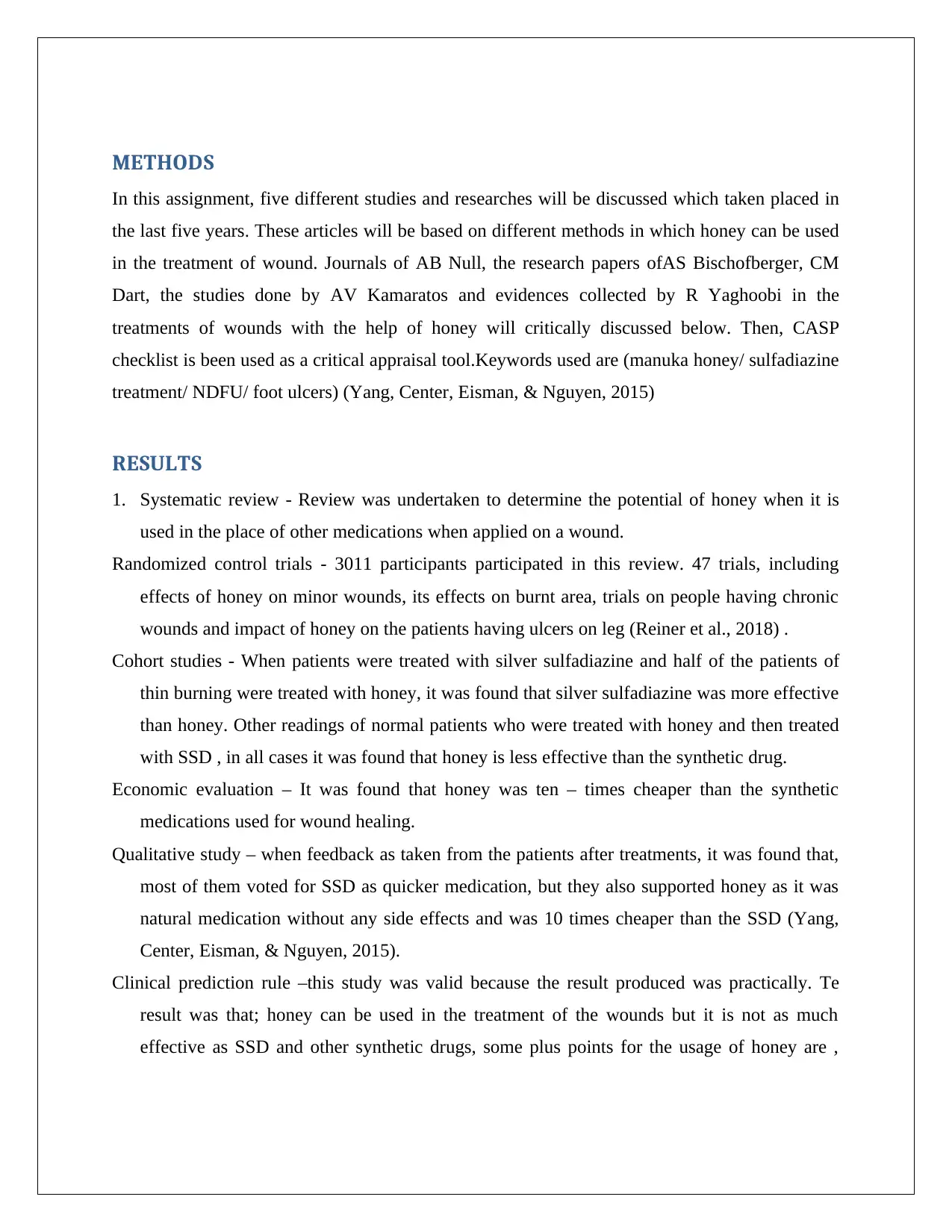
METHODS
In this assignment, five different studies and researches will be discussed which taken placed in
the last five years. These articles will be based on different methods in which honey can be used
in the treatment of wound. Journals of AB Null, the research papers ofAS Bischofberger, CM
Dart, the studies done by AV Kamaratos and evidences collected by R Yaghoobi in the
treatments of wounds with the help of honey will critically discussed below. Then, CASP
checklist is been used as a critical appraisal tool.Keywords used are (manuka honey/ sulfadiazine
treatment/ NDFU/ foot ulcers) (Yang, Center, Eisman, & Nguyen, 2015)
RESULTS
1. Systematic review - Review was undertaken to determine the potential of honey when it is
used in the place of other medications when applied on a wound.
Randomized control trials - 3011 participants participated in this review. 47 trials, including
effects of honey on minor wounds, its effects on burnt area, trials on people having chronic
wounds and impact of honey on the patients having ulcers on leg (Reiner et al., 2018) .
Cohort studies - When patients were treated with silver sulfadiazine and half of the patients of
thin burning were treated with honey, it was found that silver sulfadiazine was more effective
than honey. Other readings of normal patients who were treated with honey and then treated
with SSD , in all cases it was found that honey is less effective than the synthetic drug.
Economic evaluation – It was found that honey was ten – times cheaper than the synthetic
medications used for wound healing.
Qualitative study – when feedback as taken from the patients after treatments, it was found that,
most of them voted for SSD as quicker medication, but they also supported honey as it was
natural medication without any side effects and was 10 times cheaper than the SSD (Yang,
Center, Eisman, & Nguyen, 2015).
Clinical prediction rule –this study was valid because the result produced was practically. Te
result was that; honey can be used in the treatment of the wounds but it is not as much
effective as SSD and other synthetic drugs, some plus points for the usage of honey are ,
In this assignment, five different studies and researches will be discussed which taken placed in
the last five years. These articles will be based on different methods in which honey can be used
in the treatment of wound. Journals of AB Null, the research papers ofAS Bischofberger, CM
Dart, the studies done by AV Kamaratos and evidences collected by R Yaghoobi in the
treatments of wounds with the help of honey will critically discussed below. Then, CASP
checklist is been used as a critical appraisal tool.Keywords used are (manuka honey/ sulfadiazine
treatment/ NDFU/ foot ulcers) (Yang, Center, Eisman, & Nguyen, 2015)
RESULTS
1. Systematic review - Review was undertaken to determine the potential of honey when it is
used in the place of other medications when applied on a wound.
Randomized control trials - 3011 participants participated in this review. 47 trials, including
effects of honey on minor wounds, its effects on burnt area, trials on people having chronic
wounds and impact of honey on the patients having ulcers on leg (Reiner et al., 2018) .
Cohort studies - When patients were treated with silver sulfadiazine and half of the patients of
thin burning were treated with honey, it was found that silver sulfadiazine was more effective
than honey. Other readings of normal patients who were treated with honey and then treated
with SSD , in all cases it was found that honey is less effective than the synthetic drug.
Economic evaluation – It was found that honey was ten – times cheaper than the synthetic
medications used for wound healing.
Qualitative study – when feedback as taken from the patients after treatments, it was found that,
most of them voted for SSD as quicker medication, but they also supported honey as it was
natural medication without any side effects and was 10 times cheaper than the SSD (Yang,
Center, Eisman, & Nguyen, 2015).
Clinical prediction rule –this study was valid because the result produced was practically. Te
result was that; honey can be used in the treatment of the wounds but it is not as much
effective as SSD and other synthetic drugs, some plus points for the usage of honey are ,
Secure Best Marks with AI Grader
Need help grading? Try our AI Grader for instant feedback on your assignments.
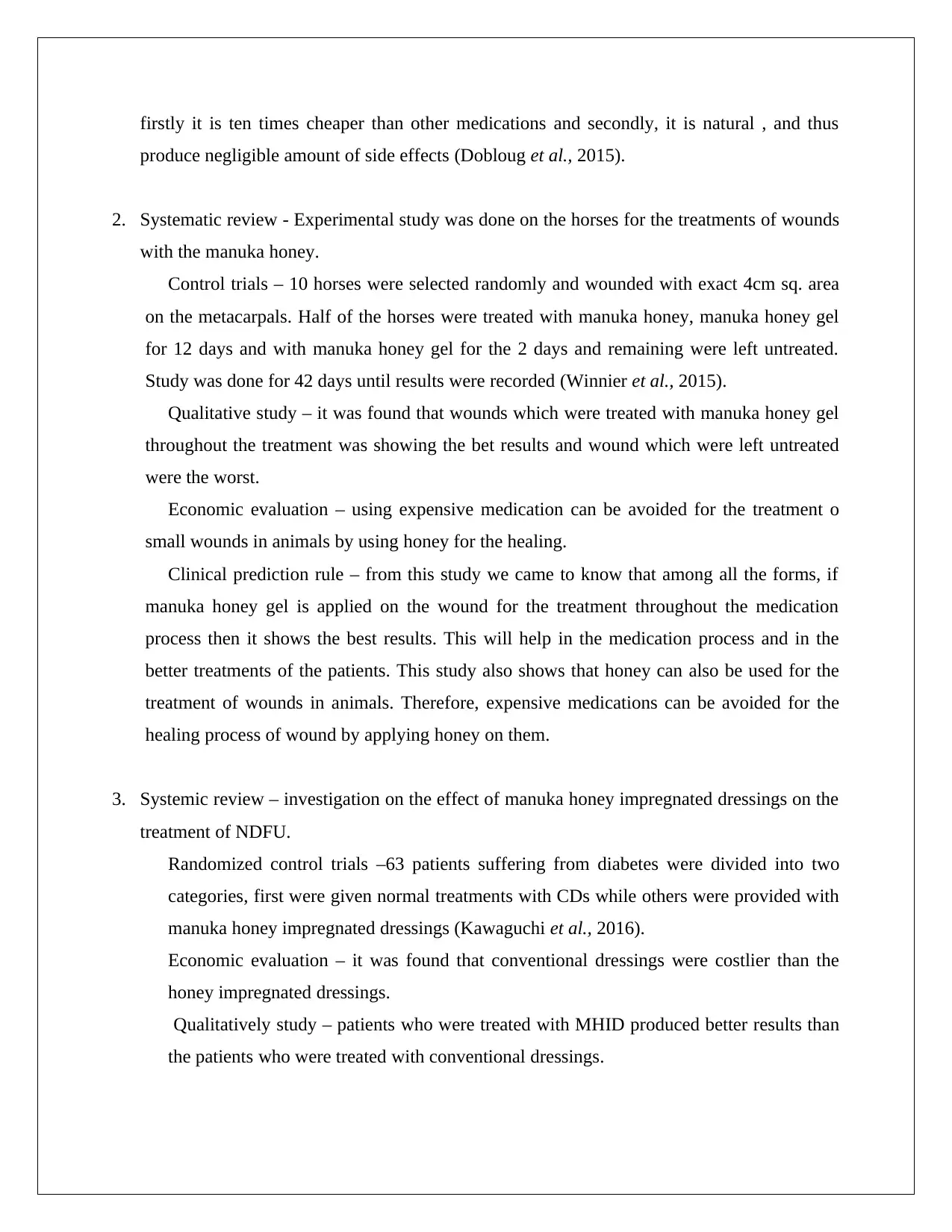
firstly it is ten times cheaper than other medications and secondly, it is natural , and thus
produce negligible amount of side effects (Dobloug et al., 2015).
2. Systematic review - Experimental study was done on the horses for the treatments of wounds
with the manuka honey.
Control trials – 10 horses were selected randomly and wounded with exact 4cm sq. area
on the metacarpals. Half of the horses were treated with manuka honey, manuka honey gel
for 12 days and with manuka honey gel for the 2 days and remaining were left untreated.
Study was done for 42 days until results were recorded (Winnier et al., 2015).
Qualitative study – it was found that wounds which were treated with manuka honey gel
throughout the treatment was showing the bet results and wound which were left untreated
were the worst.
Economic evaluation – using expensive medication can be avoided for the treatment o
small wounds in animals by using honey for the healing.
Clinical prediction rule – from this study we came to know that among all the forms, if
manuka honey gel is applied on the wound for the treatment throughout the medication
process then it shows the best results. This will help in the medication process and in the
better treatments of the patients. This study also shows that honey can also be used for the
treatment of wounds in animals. Therefore, expensive medications can be avoided for the
healing process of wound by applying honey on them.
3. Systemic review – investigation on the effect of manuka honey impregnated dressings on the
treatment of NDFU.
Randomized control trials –63 patients suffering from diabetes were divided into two
categories, first were given normal treatments with CDs while others were provided with
manuka honey impregnated dressings (Kawaguchi et al., 2016).
Economic evaluation – it was found that conventional dressings were costlier than the
honey impregnated dressings.
Qualitatively study – patients who were treated with MHID produced better results than
the patients who were treated with conventional dressings.
produce negligible amount of side effects (Dobloug et al., 2015).
2. Systematic review - Experimental study was done on the horses for the treatments of wounds
with the manuka honey.
Control trials – 10 horses were selected randomly and wounded with exact 4cm sq. area
on the metacarpals. Half of the horses were treated with manuka honey, manuka honey gel
for 12 days and with manuka honey gel for the 2 days and remaining were left untreated.
Study was done for 42 days until results were recorded (Winnier et al., 2015).
Qualitative study – it was found that wounds which were treated with manuka honey gel
throughout the treatment was showing the bet results and wound which were left untreated
were the worst.
Economic evaluation – using expensive medication can be avoided for the treatment o
small wounds in animals by using honey for the healing.
Clinical prediction rule – from this study we came to know that among all the forms, if
manuka honey gel is applied on the wound for the treatment throughout the medication
process then it shows the best results. This will help in the medication process and in the
better treatments of the patients. This study also shows that honey can also be used for the
treatment of wounds in animals. Therefore, expensive medications can be avoided for the
healing process of wound by applying honey on them.
3. Systemic review – investigation on the effect of manuka honey impregnated dressings on the
treatment of NDFU.
Randomized control trials –63 patients suffering from diabetes were divided into two
categories, first were given normal treatments with CDs while others were provided with
manuka honey impregnated dressings (Kawaguchi et al., 2016).
Economic evaluation – it was found that conventional dressings were costlier than the
honey impregnated dressings.
Qualitatively study – patients who were treated with MHID produced better results than
the patients who were treated with conventional dressings.
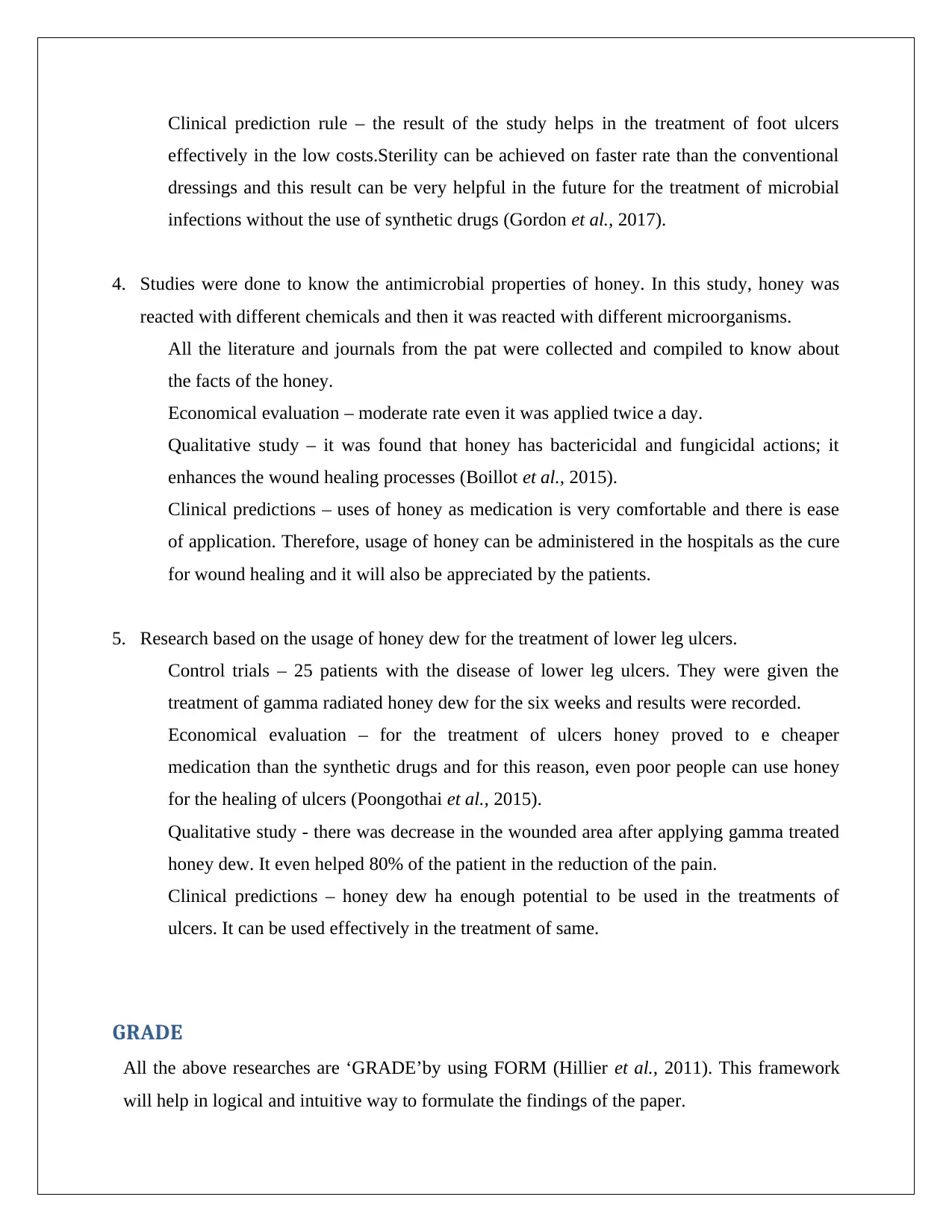
Clinical prediction rule – the result of the study helps in the treatment of foot ulcers
effectively in the low costs.Sterility can be achieved on faster rate than the conventional
dressings and this result can be very helpful in the future for the treatment of microbial
infections without the use of synthetic drugs (Gordon et al., 2017).
4. Studies were done to know the antimicrobial properties of honey. In this study, honey was
reacted with different chemicals and then it was reacted with different microorganisms.
All the literature and journals from the pat were collected and compiled to know about
the facts of the honey.
Economical evaluation – moderate rate even it was applied twice a day.
Qualitative study – it was found that honey has bactericidal and fungicidal actions; it
enhances the wound healing processes (Boillot et al., 2015).
Clinical predictions – uses of honey as medication is very comfortable and there is ease
of application. Therefore, usage of honey can be administered in the hospitals as the cure
for wound healing and it will also be appreciated by the patients.
5. Research based on the usage of honey dew for the treatment of lower leg ulcers.
Control trials – 25 patients with the disease of lower leg ulcers. They were given the
treatment of gamma radiated honey dew for the six weeks and results were recorded.
Economical evaluation – for the treatment of ulcers honey proved to e cheaper
medication than the synthetic drugs and for this reason, even poor people can use honey
for the healing of ulcers (Poongothai et al., 2015).
Qualitative study - there was decrease in the wounded area after applying gamma treated
honey dew. It even helped 80% of the patient in the reduction of the pain.
Clinical predictions – honey dew ha enough potential to be used in the treatments of
ulcers. It can be used effectively in the treatment of same.
GRADE
All the above researches are ‘GRADE’by using FORM (Hillier et al., 2011). This framework
will help in logical and intuitive way to formulate the findings of the paper.
effectively in the low costs.Sterility can be achieved on faster rate than the conventional
dressings and this result can be very helpful in the future for the treatment of microbial
infections without the use of synthetic drugs (Gordon et al., 2017).
4. Studies were done to know the antimicrobial properties of honey. In this study, honey was
reacted with different chemicals and then it was reacted with different microorganisms.
All the literature and journals from the pat were collected and compiled to know about
the facts of the honey.
Economical evaluation – moderate rate even it was applied twice a day.
Qualitative study – it was found that honey has bactericidal and fungicidal actions; it
enhances the wound healing processes (Boillot et al., 2015).
Clinical predictions – uses of honey as medication is very comfortable and there is ease
of application. Therefore, usage of honey can be administered in the hospitals as the cure
for wound healing and it will also be appreciated by the patients.
5. Research based on the usage of honey dew for the treatment of lower leg ulcers.
Control trials – 25 patients with the disease of lower leg ulcers. They were given the
treatment of gamma radiated honey dew for the six weeks and results were recorded.
Economical evaluation – for the treatment of ulcers honey proved to e cheaper
medication than the synthetic drugs and for this reason, even poor people can use honey
for the healing of ulcers (Poongothai et al., 2015).
Qualitative study - there was decrease in the wounded area after applying gamma treated
honey dew. It even helped 80% of the patient in the reduction of the pain.
Clinical predictions – honey dew ha enough potential to be used in the treatments of
ulcers. It can be used effectively in the treatment of same.
GRADE
All the above researches are ‘GRADE’by using FORM (Hillier et al., 2011). This framework
will help in logical and intuitive way to formulate the findings of the paper.

Evidence base
From the above studies it was found that honey can be used for the cure of wounds of burnings
on the skin, wounds of the animals, as an antibacterial agent and for the treatments of ulcers. To
support these, it was found that when honey was applied over wounds in place of the general
medications, honey help in the healing of wounds. When honey was reacted with certain
microorganisms, there was retardation in the rate of growth of those microorganisms which
supports that honey can be used as an antibacterial agent. It is worth to note here that, as honey
is doing both the jobs , i.e., it is helping in the healing of wounds as well as it is helping in the
prevention of the growth of microorganisms, honey can be effectively applied on the wounds as
it will prevent the infection and also provide cur to the wounds (Philpott et al., 2015).
Consistency in the treatment
As honey is natural remedy, it can be applied several times over the affected area and it will not
provide any side effects or negative impact on the health. If honey is applied in more amount
than it was needed then also it does not do any harm to the body. In this way, honey provides
consistency in the treatment of wounds. Wrapping the wounded area after application of
manuka honey over it is very much effective. Even now, a pre-packaged wound dressing which
already contains the manuka honey inside is prepared by many pharmaceutical companies.
These can be applied anytime without the need of any training (Yusuf et al., 2015).
Clinical impact
When we talk about the clinical impact of honey in the treatment of wounds, it was found that,
antibiotics which are been used in the treatment of wounds and other treatments are getting less
effective day by day. According to researches,it is estimated that after 20 years, no antibiotics
can be used in the treatment of microbial diseases. Therefore, it can be said that remedies like
honey can be used in future on large scales for the treatments of wounds and other disorders.
Very soon honey can be used for the treatment of small and chronic wounds, and for the
treatments of ulcers. Even many pharmaceutical companies have formulated certain pre-
packaged wound dressings which contains honey inside them which can be used instantly on
any wound without the any training (Kashani et al., 2017).
From the above studies it was found that honey can be used for the cure of wounds of burnings
on the skin, wounds of the animals, as an antibacterial agent and for the treatments of ulcers. To
support these, it was found that when honey was applied over wounds in place of the general
medications, honey help in the healing of wounds. When honey was reacted with certain
microorganisms, there was retardation in the rate of growth of those microorganisms which
supports that honey can be used as an antibacterial agent. It is worth to note here that, as honey
is doing both the jobs , i.e., it is helping in the healing of wounds as well as it is helping in the
prevention of the growth of microorganisms, honey can be effectively applied on the wounds as
it will prevent the infection and also provide cur to the wounds (Philpott et al., 2015).
Consistency in the treatment
As honey is natural remedy, it can be applied several times over the affected area and it will not
provide any side effects or negative impact on the health. If honey is applied in more amount
than it was needed then also it does not do any harm to the body. In this way, honey provides
consistency in the treatment of wounds. Wrapping the wounded area after application of
manuka honey over it is very much effective. Even now, a pre-packaged wound dressing which
already contains the manuka honey inside is prepared by many pharmaceutical companies.
These can be applied anytime without the need of any training (Yusuf et al., 2015).
Clinical impact
When we talk about the clinical impact of honey in the treatment of wounds, it was found that,
antibiotics which are been used in the treatment of wounds and other treatments are getting less
effective day by day. According to researches,it is estimated that after 20 years, no antibiotics
can be used in the treatment of microbial diseases. Therefore, it can be said that remedies like
honey can be used in future on large scales for the treatments of wounds and other disorders.
Very soon honey can be used for the treatment of small and chronic wounds, and for the
treatments of ulcers. Even many pharmaceutical companies have formulated certain pre-
packaged wound dressings which contains honey inside them which can be used instantly on
any wound without the any training (Kashani et al., 2017).
Paraphrase This Document
Need a fresh take? Get an instant paraphrase of this document with our AI Paraphraser

Generalisability of the use of honey in the treatments
Along with the use of honey in the cure of burnt wounds and on ulcers on foot, which were
discussed in the researches above, honey can b used in many more treatments and other
medical purposes. It can be taken on daily basis to develop immunity against many diseases.
Ulcers of the bucccal cavity and that of in stomach can also be treated with the honey. Many
medications whose preservation is very difficult can be preserved by adding honey into it (Kim
et al., 2016).
Applicability
Honey was not found to be as much efficient as the synthetic drugs in the treatments of thin and
chronic wounds. It was found honey dew gel is most effective among all the honey products
against the infection and in the treatments of wounds. Further, the use and application of honey
is very simple and easy. Therefore honey can be used in the treatments but not as much
effective than the synthetic drugs (Bassig et al., 2017). Synthetic drugs are still preferred above
the honey for the immediate treatment, cure and relief.
Along with the use of honey in the cure of burnt wounds and on ulcers on foot, which were
discussed in the researches above, honey can b used in many more treatments and other
medical purposes. It can be taken on daily basis to develop immunity against many diseases.
Ulcers of the bucccal cavity and that of in stomach can also be treated with the honey. Many
medications whose preservation is very difficult can be preserved by adding honey into it (Kim
et al., 2016).
Applicability
Honey was not found to be as much efficient as the synthetic drugs in the treatments of thin and
chronic wounds. It was found honey dew gel is most effective among all the honey products
against the infection and in the treatments of wounds. Further, the use and application of honey
is very simple and easy. Therefore honey can be used in the treatments but not as much
effective than the synthetic drugs (Bassig et al., 2017). Synthetic drugs are still preferred above
the honey for the immediate treatment, cure and relief.
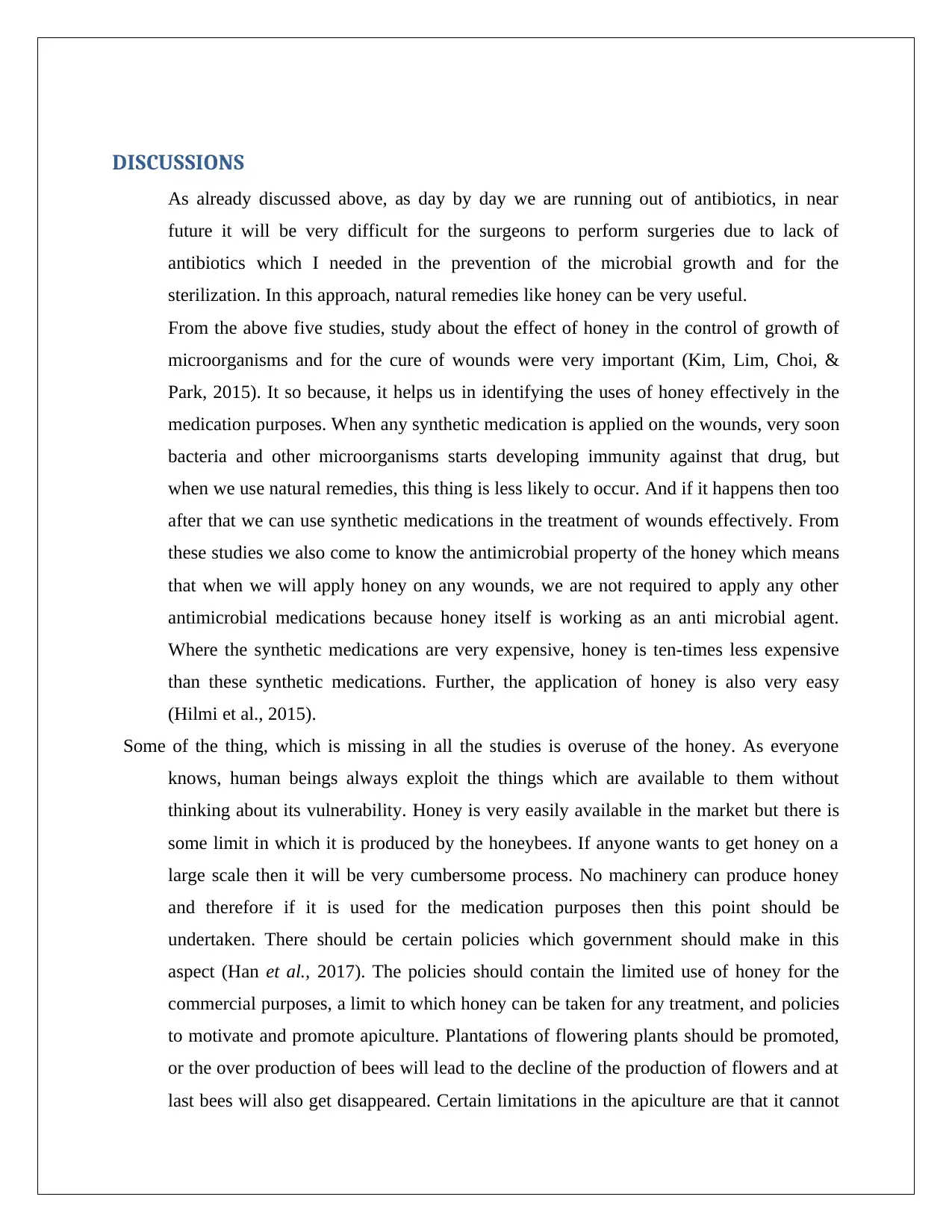
DISCUSSIONS
As already discussed above, as day by day we are running out of antibiotics, in near
future it will be very difficult for the surgeons to perform surgeries due to lack of
antibiotics which I needed in the prevention of the microbial growth and for the
sterilization. In this approach, natural remedies like honey can be very useful.
From the above five studies, study about the effect of honey in the control of growth of
microorganisms and for the cure of wounds were very important (Kim, Lim, Choi, &
Park, 2015). It so because, it helps us in identifying the uses of honey effectively in the
medication purposes. When any synthetic medication is applied on the wounds, very soon
bacteria and other microorganisms starts developing immunity against that drug, but
when we use natural remedies, this thing is less likely to occur. And if it happens then too
after that we can use synthetic medications in the treatment of wounds effectively. From
these studies we also come to know the antimicrobial property of the honey which means
that when we will apply honey on any wounds, we are not required to apply any other
antimicrobial medications because honey itself is working as an anti microbial agent.
Where the synthetic medications are very expensive, honey is ten-times less expensive
than these synthetic medications. Further, the application of honey is also very easy
(Hilmi et al., 2015).
Some of the thing, which is missing in all the studies is overuse of the honey. As everyone
knows, human beings always exploit the things which are available to them without
thinking about its vulnerability. Honey is very easily available in the market but there is
some limit in which it is produced by the honeybees. If anyone wants to get honey on a
large scale then it will be very cumbersome process. No machinery can produce honey
and therefore if it is used for the medication purposes then this point should be
undertaken. There should be certain policies which government should make in this
aspect (Han et al., 2017). The policies should contain the limited use of honey for the
commercial purposes, a limit to which honey can be taken for any treatment, and policies
to motivate and promote apiculture. Plantations of flowering plants should be promoted,
or the over production of bees will lead to the decline of the production of flowers and at
last bees will also get disappeared. Certain limitations in the apiculture are that it cannot
As already discussed above, as day by day we are running out of antibiotics, in near
future it will be very difficult for the surgeons to perform surgeries due to lack of
antibiotics which I needed in the prevention of the microbial growth and for the
sterilization. In this approach, natural remedies like honey can be very useful.
From the above five studies, study about the effect of honey in the control of growth of
microorganisms and for the cure of wounds were very important (Kim, Lim, Choi, &
Park, 2015). It so because, it helps us in identifying the uses of honey effectively in the
medication purposes. When any synthetic medication is applied on the wounds, very soon
bacteria and other microorganisms starts developing immunity against that drug, but
when we use natural remedies, this thing is less likely to occur. And if it happens then too
after that we can use synthetic medications in the treatment of wounds effectively. From
these studies we also come to know the antimicrobial property of the honey which means
that when we will apply honey on any wounds, we are not required to apply any other
antimicrobial medications because honey itself is working as an anti microbial agent.
Where the synthetic medications are very expensive, honey is ten-times less expensive
than these synthetic medications. Further, the application of honey is also very easy
(Hilmi et al., 2015).
Some of the thing, which is missing in all the studies is overuse of the honey. As everyone
knows, human beings always exploit the things which are available to them without
thinking about its vulnerability. Honey is very easily available in the market but there is
some limit in which it is produced by the honeybees. If anyone wants to get honey on a
large scale then it will be very cumbersome process. No machinery can produce honey
and therefore if it is used for the medication purposes then this point should be
undertaken. There should be certain policies which government should make in this
aspect (Han et al., 2017). The policies should contain the limited use of honey for the
commercial purposes, a limit to which honey can be taken for any treatment, and policies
to motivate and promote apiculture. Plantations of flowering plants should be promoted,
or the over production of bees will lead to the decline of the production of flowers and at
last bees will also get disappeared. Certain limitations in the apiculture are that it cannot

be done in city areas, because bees can be proved dangerous sometimes (Kim et al.,
2016).
CONCLUSION
As all the microorganisms are developing immunity against antimicrobials, it is very
necessary to check the use of antimicrobials to a limited amount. To overcome this
problem, natural remedies like honey can be used for this. One of the uses of honey in the
field of medication is in the healing of wounds. The research papers which were studied
shows that honey can be used in the treatment of wound. Homey have some properties
through which it can help in the healing of wounds. The peroxisomes present in the
honey enables it to prevent the growth of microorganisms and because of these reasons,
honey can be used on the wounded area (Tan et al., 2017). From the studies it as found
that honey is not that much effective then the synthetic drugs. Patients prefer drugs like
SSD on the honey to get faster cure and relief from the itchiness. Honey is cheaper than
the synthetic drugs and its applying process is also very easy. It helps in preventing the
spread of diseases or infections. Also many diseases like ulcers can be cured by applying
honey on them. In near future honey can be used on large scale for the control of the
spread of infections due to unavailability of the proper antimicrobials and the
antimicrobial properties of the honey. Manuka honey is preferred among all other
varieties in the treatment of wounds and many countries gave manuka honey as
recommendation for the wound treatment. Like all natural resources, availability of
honey is also limited, therefore certain policies should be made for the commercial use of
honey and government should promote the apiculture in rural areas. In near future honey
can play a vital role in the field of epidemiology.
2016).
CONCLUSION
As all the microorganisms are developing immunity against antimicrobials, it is very
necessary to check the use of antimicrobials to a limited amount. To overcome this
problem, natural remedies like honey can be used for this. One of the uses of honey in the
field of medication is in the healing of wounds. The research papers which were studied
shows that honey can be used in the treatment of wound. Homey have some properties
through which it can help in the healing of wounds. The peroxisomes present in the
honey enables it to prevent the growth of microorganisms and because of these reasons,
honey can be used on the wounded area (Tan et al., 2017). From the studies it as found
that honey is not that much effective then the synthetic drugs. Patients prefer drugs like
SSD on the honey to get faster cure and relief from the itchiness. Honey is cheaper than
the synthetic drugs and its applying process is also very easy. It helps in preventing the
spread of diseases or infections. Also many diseases like ulcers can be cured by applying
honey on them. In near future honey can be used on large scale for the control of the
spread of infections due to unavailability of the proper antimicrobials and the
antimicrobial properties of the honey. Manuka honey is preferred among all other
varieties in the treatment of wounds and many countries gave manuka honey as
recommendation for the wound treatment. Like all natural resources, availability of
honey is also limited, therefore certain policies should be made for the commercial use of
honey and government should promote the apiculture in rural areas. In near future honey
can play a vital role in the field of epidemiology.
Secure Best Marks with AI Grader
Need help grading? Try our AI Grader for instant feedback on your assignments.
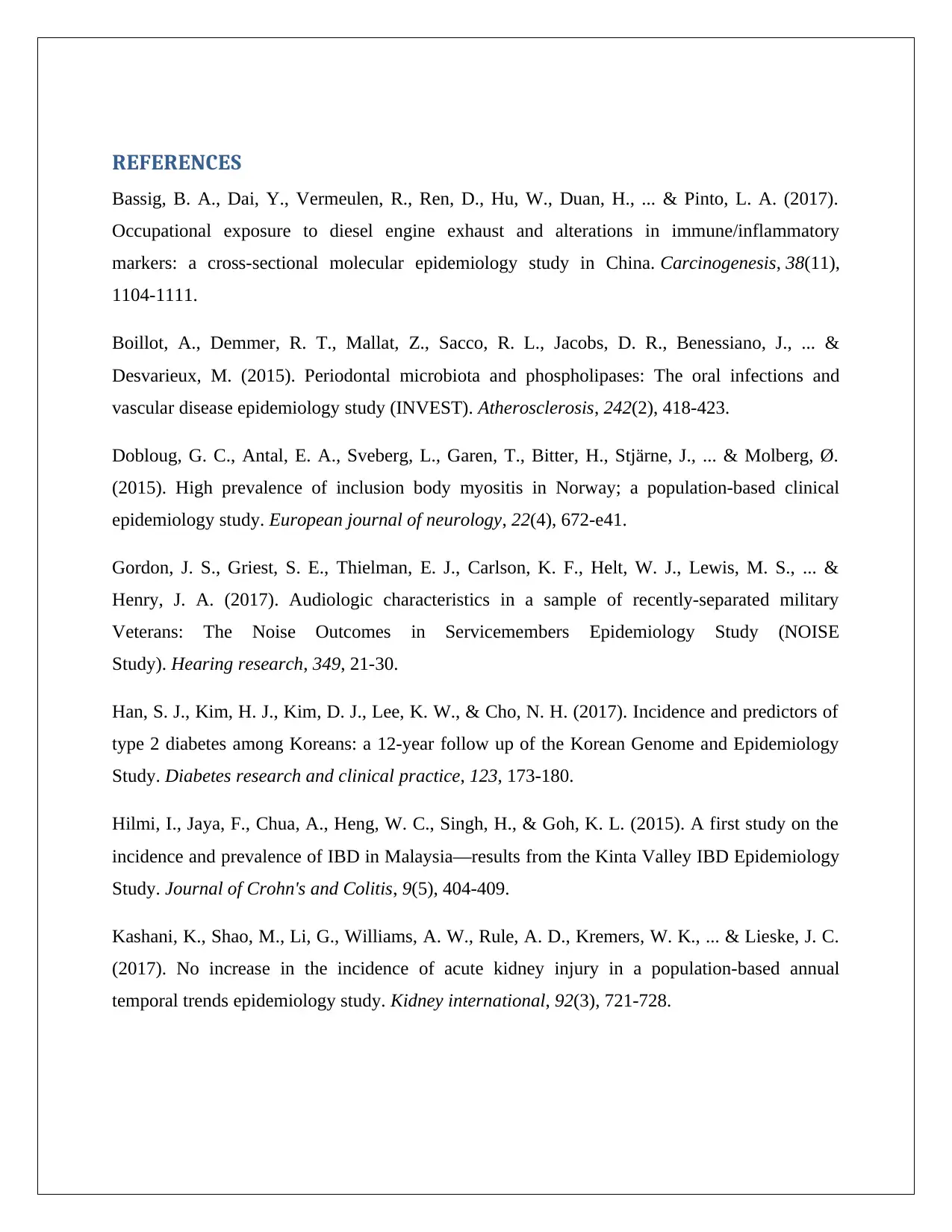
REFERENCES
Bassig, B. A., Dai, Y., Vermeulen, R., Ren, D., Hu, W., Duan, H., ... & Pinto, L. A. (2017).
Occupational exposure to diesel engine exhaust and alterations in immune/inflammatory
markers: a cross-sectional molecular epidemiology study in China. Carcinogenesis, 38(11),
1104-1111.
Boillot, A., Demmer, R. T., Mallat, Z., Sacco, R. L., Jacobs, D. R., Benessiano, J., ... &
Desvarieux, M. (2015). Periodontal microbiota and phospholipases: The oral infections and
vascular disease epidemiology study (INVEST). Atherosclerosis, 242(2), 418-423.
Dobloug, G. C., Antal, E. A., Sveberg, L., Garen, T., Bitter, H., Stjärne, J., ... & Molberg, Ø.
(2015). High prevalence of inclusion body myositis in Norway; a population‐based clinical
epidemiology study. European journal of neurology, 22(4), 672-e41.
Gordon, J. S., Griest, S. E., Thielman, E. J., Carlson, K. F., Helt, W. J., Lewis, M. S., ... &
Henry, J. A. (2017). Audiologic characteristics in a sample of recently-separated military
Veterans: The Noise Outcomes in Servicemembers Epidemiology Study (NOISE
Study). Hearing research, 349, 21-30.
Han, S. J., Kim, H. J., Kim, D. J., Lee, K. W., & Cho, N. H. (2017). Incidence and predictors of
type 2 diabetes among Koreans: a 12-year follow up of the Korean Genome and Epidemiology
Study. Diabetes research and clinical practice, 123, 173-180.
Hilmi, I., Jaya, F., Chua, A., Heng, W. C., Singh, H., & Goh, K. L. (2015). A first study on the
incidence and prevalence of IBD in Malaysia—results from the Kinta Valley IBD Epidemiology
Study. Journal of Crohn's and Colitis, 9(5), 404-409.
Kashani, K., Shao, M., Li, G., Williams, A. W., Rule, A. D., Kremers, W. K., ... & Lieske, J. C.
(2017). No increase in the incidence of acute kidney injury in a population-based annual
temporal trends epidemiology study. Kidney international, 92(3), 721-728.
Bassig, B. A., Dai, Y., Vermeulen, R., Ren, D., Hu, W., Duan, H., ... & Pinto, L. A. (2017).
Occupational exposure to diesel engine exhaust and alterations in immune/inflammatory
markers: a cross-sectional molecular epidemiology study in China. Carcinogenesis, 38(11),
1104-1111.
Boillot, A., Demmer, R. T., Mallat, Z., Sacco, R. L., Jacobs, D. R., Benessiano, J., ... &
Desvarieux, M. (2015). Periodontal microbiota and phospholipases: The oral infections and
vascular disease epidemiology study (INVEST). Atherosclerosis, 242(2), 418-423.
Dobloug, G. C., Antal, E. A., Sveberg, L., Garen, T., Bitter, H., Stjärne, J., ... & Molberg, Ø.
(2015). High prevalence of inclusion body myositis in Norway; a population‐based clinical
epidemiology study. European journal of neurology, 22(4), 672-e41.
Gordon, J. S., Griest, S. E., Thielman, E. J., Carlson, K. F., Helt, W. J., Lewis, M. S., ... &
Henry, J. A. (2017). Audiologic characteristics in a sample of recently-separated military
Veterans: The Noise Outcomes in Servicemembers Epidemiology Study (NOISE
Study). Hearing research, 349, 21-30.
Han, S. J., Kim, H. J., Kim, D. J., Lee, K. W., & Cho, N. H. (2017). Incidence and predictors of
type 2 diabetes among Koreans: a 12-year follow up of the Korean Genome and Epidemiology
Study. Diabetes research and clinical practice, 123, 173-180.
Hilmi, I., Jaya, F., Chua, A., Heng, W. C., Singh, H., & Goh, K. L. (2015). A first study on the
incidence and prevalence of IBD in Malaysia—results from the Kinta Valley IBD Epidemiology
Study. Journal of Crohn's and Colitis, 9(5), 404-409.
Kashani, K., Shao, M., Li, G., Williams, A. W., Rule, A. D., Kremers, W. K., ... & Lieske, J. C.
(2017). No increase in the incidence of acute kidney injury in a population-based annual
temporal trends epidemiology study. Kidney international, 92(3), 721-728.
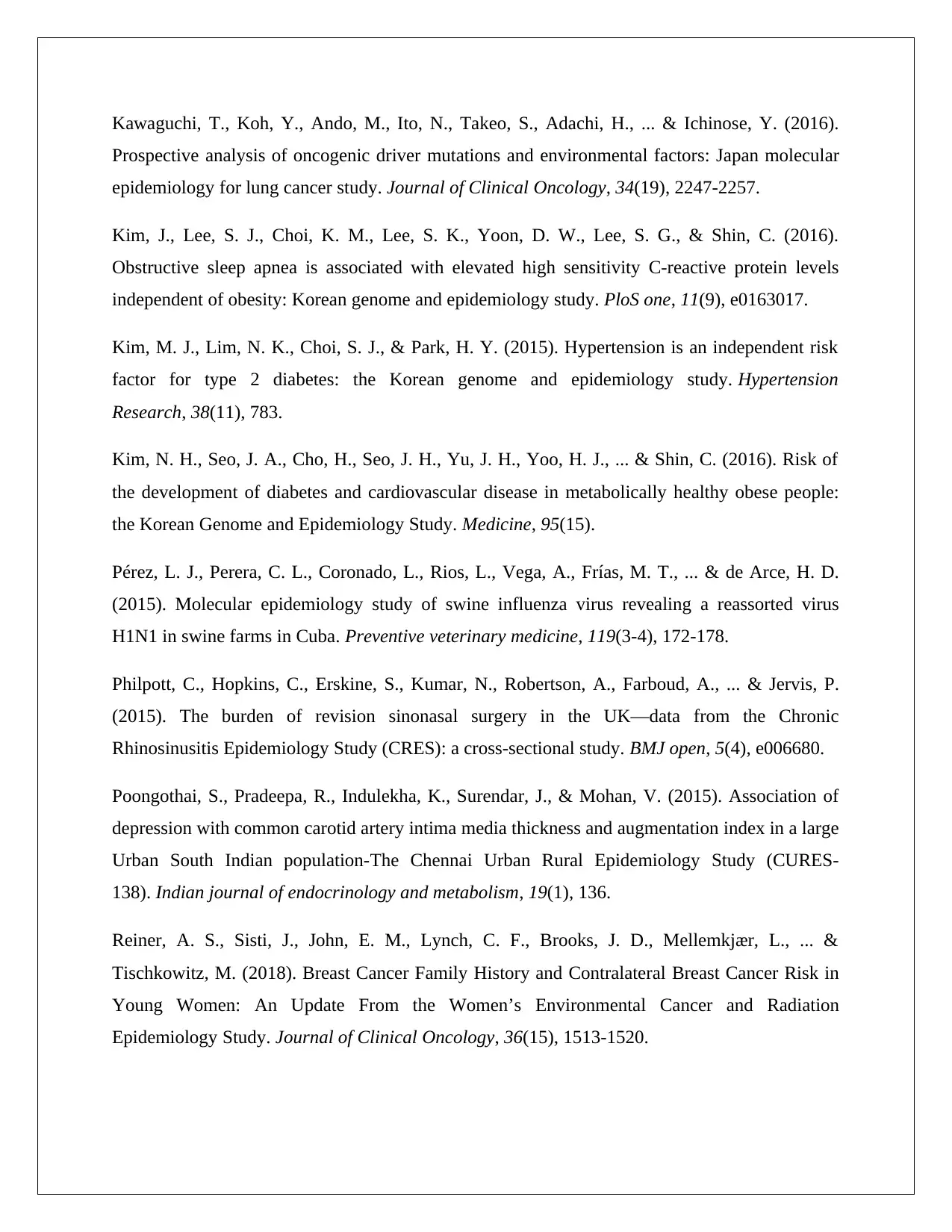
Kawaguchi, T., Koh, Y., Ando, M., Ito, N., Takeo, S., Adachi, H., ... & Ichinose, Y. (2016).
Prospective analysis of oncogenic driver mutations and environmental factors: Japan molecular
epidemiology for lung cancer study. Journal of Clinical Oncology, 34(19), 2247-2257.
Kim, J., Lee, S. J., Choi, K. M., Lee, S. K., Yoon, D. W., Lee, S. G., & Shin, C. (2016).
Obstructive sleep apnea is associated with elevated high sensitivity C-reactive protein levels
independent of obesity: Korean genome and epidemiology study. PloS one, 11(9), e0163017.
Kim, M. J., Lim, N. K., Choi, S. J., & Park, H. Y. (2015). Hypertension is an independent risk
factor for type 2 diabetes: the Korean genome and epidemiology study. Hypertension
Research, 38(11), 783.
Kim, N. H., Seo, J. A., Cho, H., Seo, J. H., Yu, J. H., Yoo, H. J., ... & Shin, C. (2016). Risk of
the development of diabetes and cardiovascular disease in metabolically healthy obese people:
the Korean Genome and Epidemiology Study. Medicine, 95(15).
Pérez, L. J., Perera, C. L., Coronado, L., Rios, L., Vega, A., Frías, M. T., ... & de Arce, H. D.
(2015). Molecular epidemiology study of swine influenza virus revealing a reassorted virus
H1N1 in swine farms in Cuba. Preventive veterinary medicine, 119(3-4), 172-178.
Philpott, C., Hopkins, C., Erskine, S., Kumar, N., Robertson, A., Farboud, A., ... & Jervis, P.
(2015). The burden of revision sinonasal surgery in the UK—data from the Chronic
Rhinosinusitis Epidemiology Study (CRES): a cross-sectional study. BMJ open, 5(4), e006680.
Poongothai, S., Pradeepa, R., Indulekha, K., Surendar, J., & Mohan, V. (2015). Association of
depression with common carotid artery intima media thickness and augmentation index in a large
Urban South Indian population-The Chennai Urban Rural Epidemiology Study (CURES-
138). Indian journal of endocrinology and metabolism, 19(1), 136.
Reiner, A. S., Sisti, J., John, E. M., Lynch, C. F., Brooks, J. D., Mellemkjær, L., ... &
Tischkowitz, M. (2018). Breast Cancer Family History and Contralateral Breast Cancer Risk in
Young Women: An Update From the Women’s Environmental Cancer and Radiation
Epidemiology Study. Journal of Clinical Oncology, 36(15), 1513-1520.
Prospective analysis of oncogenic driver mutations and environmental factors: Japan molecular
epidemiology for lung cancer study. Journal of Clinical Oncology, 34(19), 2247-2257.
Kim, J., Lee, S. J., Choi, K. M., Lee, S. K., Yoon, D. W., Lee, S. G., & Shin, C. (2016).
Obstructive sleep apnea is associated with elevated high sensitivity C-reactive protein levels
independent of obesity: Korean genome and epidemiology study. PloS one, 11(9), e0163017.
Kim, M. J., Lim, N. K., Choi, S. J., & Park, H. Y. (2015). Hypertension is an independent risk
factor for type 2 diabetes: the Korean genome and epidemiology study. Hypertension
Research, 38(11), 783.
Kim, N. H., Seo, J. A., Cho, H., Seo, J. H., Yu, J. H., Yoo, H. J., ... & Shin, C. (2016). Risk of
the development of diabetes and cardiovascular disease in metabolically healthy obese people:
the Korean Genome and Epidemiology Study. Medicine, 95(15).
Pérez, L. J., Perera, C. L., Coronado, L., Rios, L., Vega, A., Frías, M. T., ... & de Arce, H. D.
(2015). Molecular epidemiology study of swine influenza virus revealing a reassorted virus
H1N1 in swine farms in Cuba. Preventive veterinary medicine, 119(3-4), 172-178.
Philpott, C., Hopkins, C., Erskine, S., Kumar, N., Robertson, A., Farboud, A., ... & Jervis, P.
(2015). The burden of revision sinonasal surgery in the UK—data from the Chronic
Rhinosinusitis Epidemiology Study (CRES): a cross-sectional study. BMJ open, 5(4), e006680.
Poongothai, S., Pradeepa, R., Indulekha, K., Surendar, J., & Mohan, V. (2015). Association of
depression with common carotid artery intima media thickness and augmentation index in a large
Urban South Indian population-The Chennai Urban Rural Epidemiology Study (CURES-
138). Indian journal of endocrinology and metabolism, 19(1), 136.
Reiner, A. S., Sisti, J., John, E. M., Lynch, C. F., Brooks, J. D., Mellemkjær, L., ... &
Tischkowitz, M. (2018). Breast Cancer Family History and Contralateral Breast Cancer Risk in
Young Women: An Update From the Women’s Environmental Cancer and Radiation
Epidemiology Study. Journal of Clinical Oncology, 36(15), 1513-1520.
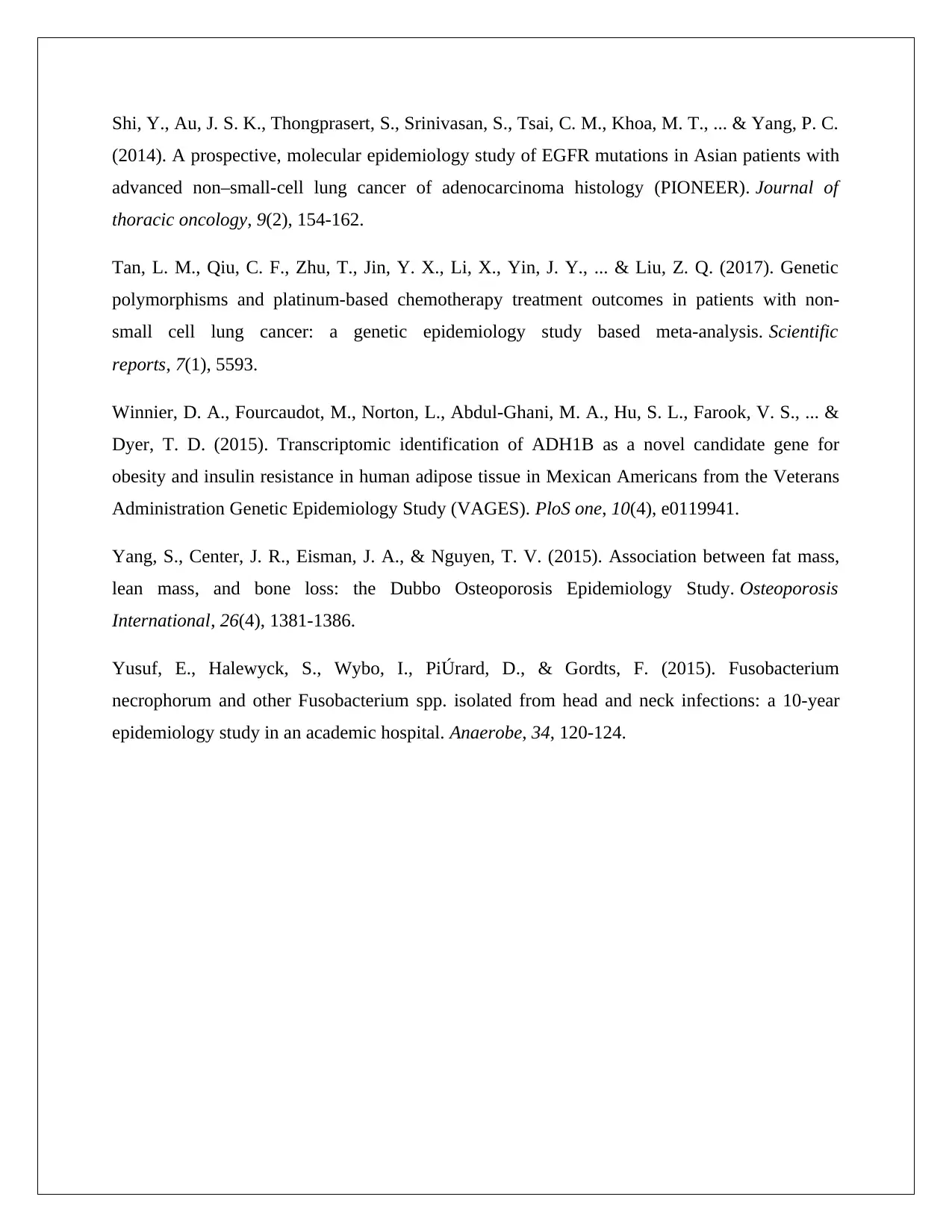
Shi, Y., Au, J. S. K., Thongprasert, S., Srinivasan, S., Tsai, C. M., Khoa, M. T., ... & Yang, P. C.
(2014). A prospective, molecular epidemiology study of EGFR mutations in Asian patients with
advanced non–small-cell lung cancer of adenocarcinoma histology (PIONEER). Journal of
thoracic oncology, 9(2), 154-162.
Tan, L. M., Qiu, C. F., Zhu, T., Jin, Y. X., Li, X., Yin, J. Y., ... & Liu, Z. Q. (2017). Genetic
polymorphisms and platinum-based chemotherapy treatment outcomes in patients with non-
small cell lung cancer: a genetic epidemiology study based meta-analysis. Scientific
reports, 7(1), 5593.
Winnier, D. A., Fourcaudot, M., Norton, L., Abdul-Ghani, M. A., Hu, S. L., Farook, V. S., ... &
Dyer, T. D. (2015). Transcriptomic identification of ADH1B as a novel candidate gene for
obesity and insulin resistance in human adipose tissue in Mexican Americans from the Veterans
Administration Genetic Epidemiology Study (VAGES). PloS one, 10(4), e0119941.
Yang, S., Center, J. R., Eisman, J. A., & Nguyen, T. V. (2015). Association between fat mass,
lean mass, and bone loss: the Dubbo Osteoporosis Epidemiology Study. Osteoporosis
International, 26(4), 1381-1386.
Yusuf, E., Halewyck, S., Wybo, I., PiÚrard, D., & Gordts, F. (2015). Fusobacterium
necrophorum and other Fusobacterium spp. isolated from head and neck infections: a 10-year
epidemiology study in an academic hospital. Anaerobe, 34, 120-124.
(2014). A prospective, molecular epidemiology study of EGFR mutations in Asian patients with
advanced non–small-cell lung cancer of adenocarcinoma histology (PIONEER). Journal of
thoracic oncology, 9(2), 154-162.
Tan, L. M., Qiu, C. F., Zhu, T., Jin, Y. X., Li, X., Yin, J. Y., ... & Liu, Z. Q. (2017). Genetic
polymorphisms and platinum-based chemotherapy treatment outcomes in patients with non-
small cell lung cancer: a genetic epidemiology study based meta-analysis. Scientific
reports, 7(1), 5593.
Winnier, D. A., Fourcaudot, M., Norton, L., Abdul-Ghani, M. A., Hu, S. L., Farook, V. S., ... &
Dyer, T. D. (2015). Transcriptomic identification of ADH1B as a novel candidate gene for
obesity and insulin resistance in human adipose tissue in Mexican Americans from the Veterans
Administration Genetic Epidemiology Study (VAGES). PloS one, 10(4), e0119941.
Yang, S., Center, J. R., Eisman, J. A., & Nguyen, T. V. (2015). Association between fat mass,
lean mass, and bone loss: the Dubbo Osteoporosis Epidemiology Study. Osteoporosis
International, 26(4), 1381-1386.
Yusuf, E., Halewyck, S., Wybo, I., PiÚrard, D., & Gordts, F. (2015). Fusobacterium
necrophorum and other Fusobacterium spp. isolated from head and neck infections: a 10-year
epidemiology study in an academic hospital. Anaerobe, 34, 120-124.
1 out of 13
Your All-in-One AI-Powered Toolkit for Academic Success.
+13062052269
info@desklib.com
Available 24*7 on WhatsApp / Email
![[object Object]](/_next/static/media/star-bottom.7253800d.svg)
Unlock your academic potential
© 2024 | Zucol Services PVT LTD | All rights reserved.
